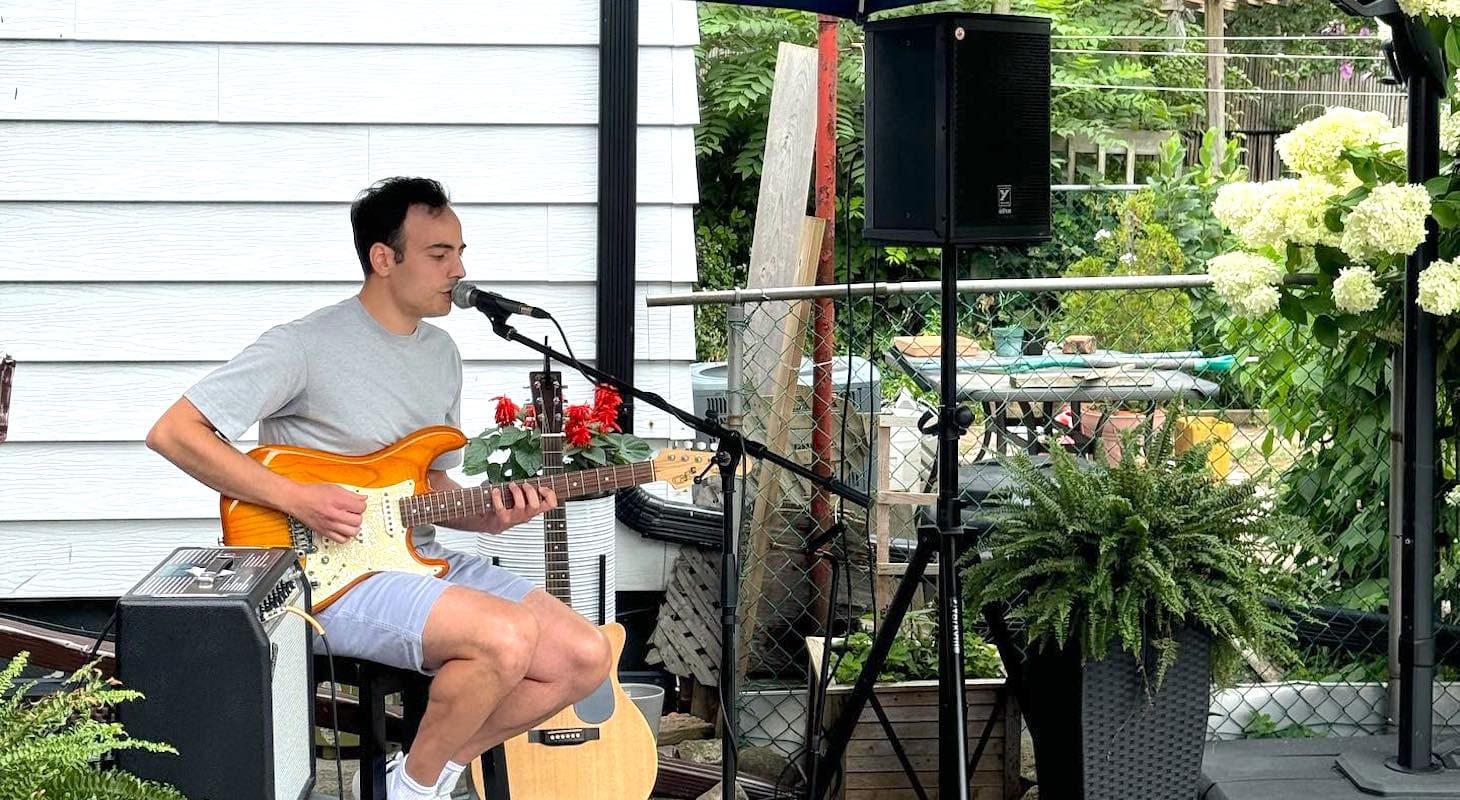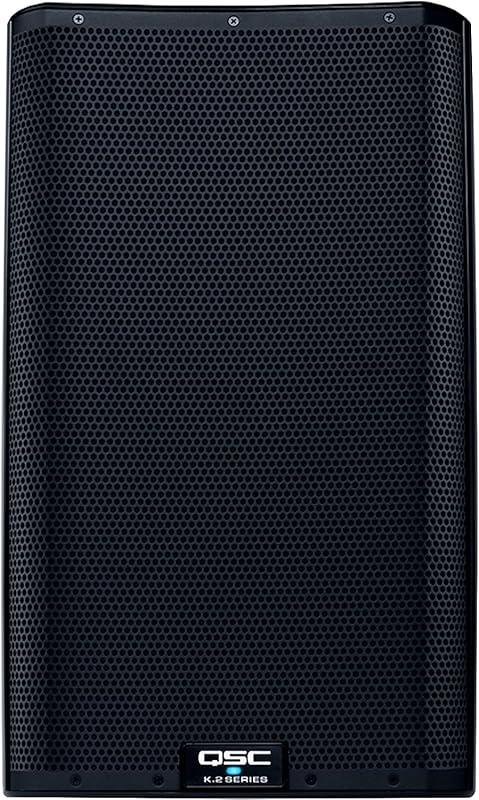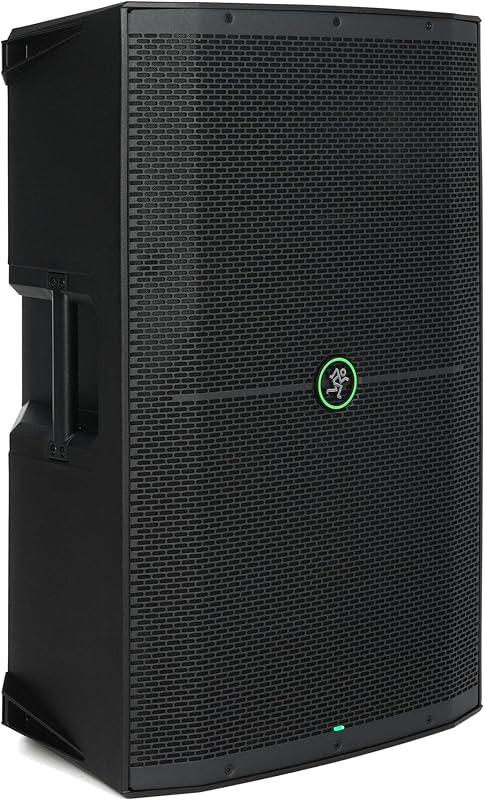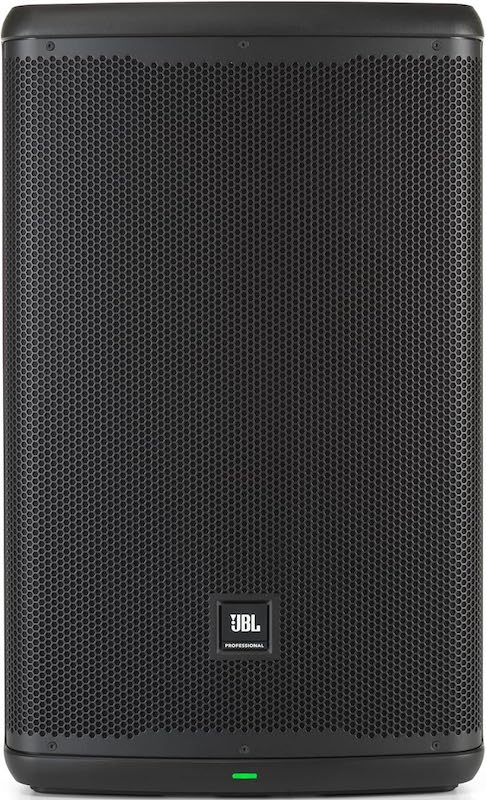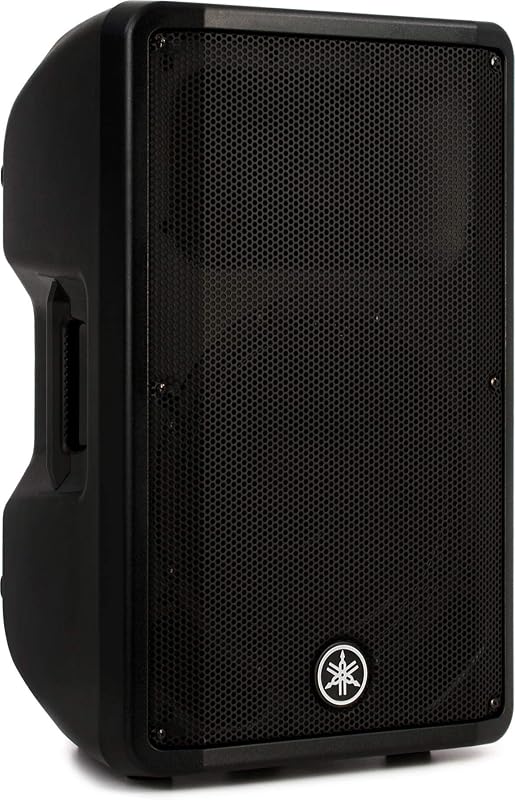Translating a good mix from the studio to the stage can be tricky without the right PA system. Even some renowned clubs that host numerous bands have disappointing sound systems.
This is something all bands must cope with, but they can control having a great PA for both rehearsals and gigs where they bring their own sound system. For almost every band I've produced, I've volunteered to not only advise but also set up their rehearsal space PA system.
It's that important for them to really hear themselves — and also potentially impress record label executives, managers, and press interviewers who visit the rehearsal spot.
Top 3 - Powered Speakers for Live Bands
Preview | Product | Price |
|---|---|---|
Here are my top five choices for powered speakers that rock! These will impress both the audience and any visitors who stop by your rehearsal space.
5 Ideal Powered Speakers for Live Bands
1. QSC K12.2
QSC has always been one of my favorite companies because of their amazing power amplifiers. They really are a cut above many others. The QSC K12.2 is probably one of their best models ever made.
Not only does it have a 2000W Class D power module, but it also has incredible sounding low-frequency drivers and high-frequency drivers to really bring out a modern crispness that a lot of PA systems lack.
I don't know if you've noticed, but a lot of PA systems usually either sound a little bit muddy and have way too much bass, or they sound a little bit harsh in the high end. When turned up really loud, especially in rehearsal rooms, they just have an insane amount of sibilance.
The QSC K12.2 has one of the best high-end drivers I've ever heard, and the delivery, especially for vocals and electric guitars, is amazing. I always recommend the QSC for rock bands that have a lot of both acoustic and electric guitars with synth layers on top. Like prog rock, country, or metal bands.
What's also great about the speakers is that they are very versatile since they have a technology called DMT, which stands for Directivity Matched Transition. In other words, they adapt and tune with the room that they're in through a very sophisticated DSP system.
This DSP correction really helps dial in a specific sound for your needs. On top of that, they have really amazing factory presets that cover all types of music, including dance, rock, and country.
But going even further than that, they have specific applications such as stage monitor, instrument amplifier, or vocal monitor presets that cater to the most popular uses of these types of amplification live.
I especially love the stage monitor preset because it helps prevent feedback, which is a big problem with stage monitoring.
How many of you have been to a gig where the moment they unmute the mics, you hear this high-pitched feedback? That's because the stage monitors have a very direct line into the Shure SM58 or whatever microphone is being used live, so it's feeding back onto itself and into the PA system that goes to the front of the house. This creates a loop which produces that horribly high-pitched noise.
The DMT DSP helps prevent some of these peaks as well as letting you adjust the crossover points.
What this means is that you can dial in different frequencies depending on the type of music that you're playing. Some rock bands these days have a lot of synth bass — even bands like Radiohead double a lot of their bass with synth bass.
In order for that to not become a muddy mess, you really need amplification that has good crossover points. That’s why these also rock as stage monitors.
2. Mackie Thump215XT Enhanced
For pop music, I don't think there's a better speaker than the Mackie Thump215XT. First of all, they feature a 15-inch driver, and even though they have fewer watts than the QSC, the way Mackie delivers low frequency response is unbelievable.
I still use the Mackie HR824 monitors in the studio precisely because their bass is both amazing and accurate. I've bought other monitors that have incredible bass — they sound great in the studio, but when you take your mix elsewhere, you realize it lacks much of the bass you were hearing. That's because companies like KRK and Genelec artificially boost the bass.
You might think, "Well, even if it's artificially boosted, isn't that good for live performances?" Not necessarily. Many bands use stems from recording sessions and trigger them through Ableton Live or Logic while playing on top.
These stems often contain significant bass — they may include loops with sub kick drums or modular synth bass captured during the recording sessions since there’s no official keyboard player in the band.
Stems can quickly saturate a PA system because they're typically mastered to be loud and full of bass and highs.
If your band uses lots of stems for playback, I strongly recommend the Mackie Thump. They're perfect for Pop with electronic influences like Maroon 5 or Bruno Mars. They're also ideal for electronic bands that rely more on loops and synth parts than drummers.
I love their Bluetooth compatibility for those times when you need to play a quick showcase without the whole band—perhaps just using a mastered instrumental track with the vocalist and guitarist. You can easily play from any iOS device or offstage laptop via Bluetooth. It's convenient and extremely stable on the Mackies.
These speakers are also conveniently lightweight. They're my PA choice when DJing live because I typically bring analog synthesizers too — a Moog Subsequent 37 for bass and a Sequential Take 5 for arpeggios, chords, and pads.
Synth sounds, especially analog, are incredible through the Mackies. There's something special about their low-end woofers combined with their power distribution that delivers tight bass with substantial sub frequencies — all without needing a separate subwoofer.
For electronic music, DJing, Pop, or R&B, the delivery of low end — particularly kick drums layered with analog-style bass — is crucial. I understand why they call it the "Thump" because it truly kicks you in the chest.
I also appreciate their different modes for tuning to specific rooms, unlike the QSC's DSP-based EQ tuning. The Mackie offers more general applications, with indoor/outdoor settings that change how it disperses sound.
I occasionally use them as monitors when necessary, though I wouldn't typically recommend this — they're simply too good for such a basic application.
Vocals sound excellent through these speakers thanks to a crisp, modern boost in the 10k–12k range, which really enhances vocals in pre-recorded stems and tracks. For my live performances, I bring different Ableton stems — main rhythm track, analog arpeggios and pads, vocals, and miscellaneous guitars — then add live Moog bass and select sounds from the Sequential Take 5.
They're also excellent with live vocalists who join me on stage, even during DJ sets. Overall, for modern music outside the traditional rock band style, I highly recommend these Mackie speakers.
3. Behringer B15X
Say what you will about Behringer as a dodgy brand or one that constantly repackages others' designs at a lower price — there's a lot of Behringer hate out there. Many feel they're just trying to squeeze the competition, but I have to say their products are fantastic.
The reason they can do this is because Behringer has acquired many audio companies that do everything from selling tubes to manufacturing parts for other brands. They even supply competitors with their parts.
That's how huge this company is.
What they do is essentially "Frankenstein" together the best parts from different brands to make one über-powerful product. They're not really doing anything shady since they own all these parts.
It's perhaps more a lack of imagination and creativity on their part, but regardless, their B15X 15-inch powered speakers are incredible.
I use these when there’s many playback tracks involved. Whether the vocalist is singing for real or lip-syncing doesn't matter — full master tracks through the B15X sound almost like you're hearing them in a recording studio.
This is because Behringer uses a 1.35" aluminum diaphragm compression driver, which is a new technology that delivers impeccable mids and highs.
The sound is very similar to what you would hear through $10,000 Barefoot speakers. So in many ways, though this is a live PA system, it's almost a hybrid between a live PA system and large reference monitors that would be mounted in a high-end recording studio.
In fact, I have a friend with a large recording studio built in the 1970s. He has a room where he tests how mixes translate into every format — from vinyl to cheap Bluetooth speakers to larger club speakers and live PA systems. He chose the Behringer B15X to represent the perfect balance for live PA.
Circling back to Behringer owning so many music companies that make parts and accessories: They also own Klark Teknik, which makes new versions of classic rack gear like Pultec EQs and LA-2A compressors. They're essentially the competition for Warm Audio.
Klark Teknik also creates amazing DSP, digital parts, and units for mixers, including the Midas mixers (also owned by Behringer).
That Klark Teknik DSP is included in these monitors, so you're getting both a hybrid professional studio reference system with a mixing board DSP. You could say this PA system is like having a front-of-house engineer's mixing board loaded into the back of each speaker.
I kid you not — if you hear these in a rehearsal spot, you won't believe how accurately they reproduce mixes.
For live bands, they're equally well-suited, except they're 1000W. For rehearsal spots, that's perfectly fine. If you're using these outdoors, they might not have as much power as the QSC.
I'd recommend these for smaller venues or rehearsal spots where you'll showcase more mastered tracks with perhaps one or two instruments over them. They're amazing for vocalist performance showcases — maybe for a record label or a press event — where you just have a mastered instrumental playing via Bluetooth and one mic going into the DSP directly.
You'll get an amazing balance without needing a mixing board.
4. JBL EON715
JBL is a classic brand that has been around for decades and makes incredible professional studio mixing monitors. The EON series is absolutely top-notch for bands.
I have a rehearsal spot where I use both the Mackie Thumps and EON715 monitors in different rooms.
While I use the Mackies more for my DJ and electronic music, I prefer the JBL when rehearsing with a live band. Compared to QSC and Behringer, I'll admit the JBL is hyped up — it's not a true-sounding speaker.
But hey, they sound incredible because they’re hyped up the right way — they don't get harsh or muddy with too much bass. They also help your band sound like they have more punch and power than they actually do, and trust me, many bands need that boost even when they're talented.
These speakers are my choice for indie or singer-songwriter performances rather than in-your-face rock or metal band performances.
I think this is because the tweeter is quite bright, but in a pleasant way. It's smoother than many other tweeters, so when a mellow vocalist or indie singer-songwriter performs through it, it nicely boosts their vocal presence.
That's why I prefer using these for live performances rather than pre-recorded stems. Stems typically don't need help since they come pre-mastered and compressed from the recording studio, whereas bands and vocalists often need assistance as they can sound somewhat weak without proper amplification.
Despite having only 1300W, these speakers distribute power with amazing crossovers. They're also incredibly user-friendly with a nice LCD screen for accessing different PA systems.
One feature I use constantly is the EQ parameters — there's something remarkably musical about the JBL EQ, as it's perfectly designed for easy boosting of lows and highs.
I've noticed that when mixing in a recording studio, you spend considerable time adjusting the midrange, especially with guitar-heavy tracks. Most PA system EQs and DSPs don't adequately address the midrange, focusing instead on the two drivers: high end and low end.
The midrange often lacks impact and is treated merely as a crossover between the main frequencies.
The JBL is different. It addresses the midrange in a really natural way — another reason I love it for singer-songwriter material.
Since the high-frequency driver uses a neodymium tweeter, it's almost like listening to inside out headphones, if that makes sense. If you've checked the specs on your favorite headphones, they likely use a neodymium magnet circuit to translate the high-end beautifully.
That was my first impression when listening to these speakers with an intimate singer-songwriter performance. I could've sworn I was hearing headphones in a large room. That's exactly how I'd describe it.
So if you're working with delicate, acoustic material — strings, acoustic guitars, piano — anything with subtle vibrations, detail, and emotion—this is the speaker for you.
5. Yamaha DBR12
One thing I've noticed from reviewing and owning many Yamaha products throughout my life is that Yamaha tends to be the Swiss Army knife of any product category. Think about it — their workstations like the Montage are always chock-full of every feature you could ever want.
Their drum sets are consistently the most versatile, working for any style, and sticking to that tradition, the Yamaha DBR12 is exactly that: the speaker that encapsulates all others.
They have powerful amplification, despite being only 1000W total. They also have a tuning quality similar to the QSC that ensures they adapt smoothly to different room sizes. In classic Yamaha fashion, they probably have the most complete and powerful mixing board features, rivaled only by the Behringer.
In keeping with typical Yamaha business practices, they're incredible value for everything you get — they're even cheaper than the Behringer.
These are by far the loudest of the bunch. Despite their limited wattage, they hit 131dB SPL, and they sound so powerful and impressive — between the distribution and the onboard mixer and DSP — that you'd think they're hitting 140 or 150.
These are definitely the power speakers for loud heavy metal, high-energy rock bands, or even synth-style bands like Muse that need substantial power to hit the audience in the face.
I also use these and find them perfect for hip-hop.
Hip-hop is always tricky because it's very vocal-based, but many other monitors like the Mackie and the Behringer are almost too clean and polished — too "real" for lack of a better word.
Hip-hop works best with, in a way, cheaper gear. I know that might sound funny coming from an audiophile like me who's constantly trying to find the best price for the best gear, but it's true.
When I hear hip-hop — both tracks and rappers — going through these speakers, there's just a certain way the high-frequency driver compresses naturally and the subwoofer reacts to those 808 kicks, especially in trap music, that creates the perfect fit.
Much like their drum sets (Yamaha makes probably the best Latin music drum sets ever, maybe by accident, maybe on purpose — who knows), I will say that these are my favorite urban and hip-hop speakers.
There are two things you need when you're banging out huge tracks like Drake, Tyler, The Creator, Eminem, and Kendrick Lamar:
One is obviously the bass, which this does spectacularly since the low-end driver has 80% of the power with 800W directed toward it, and you can hear it. No distortion happens even with the biggest 808 kicks.
Second, you need a powerful yet not too detailed high-frequency driver. The best thing Yamaha did with these speakers is actually limiting the high-frequency driver to 200W. In a way, they've almost made these like the infamous NS-10s of PA systems.
Their lack of detail, clarity, and crispness in the high end actually softens much of the aggressive edge that many urban and hip-hop singers have. It also softens the hi-hats that are constant in many top-loop hip-hop tracks, especially trap music with that 32nd hi-hat double-time feel.
When you put those things together, you understand better why these are perfect for that style.
They also work for other styles. I'm not saying you have to use these for hip-hop — I'm just saying that personally, I think they're almost made for it.
Tips for Finding the Perfect PA Speakers
Indoor vs. Outdoor
Finding the perfect PA system is always tricky because many sound very different in a rehearsal space compared to outdoors. If you plan to use one system for both environments, you're better off with a PA system that has a crossover tuning system.
Determining how different frequencies come through indoors versus outdoors can be challenging if you're not a seasoned front-of-house engineer. Fortunately, several of these systems have specific presets that adjust which frequencies to reduce and which to enhance when changing venues dramatically.
Power
If your band needs to fill a large space — such as a rock-oriented club or an open outdoor area — then more watts are generally better.
However, power requirements can be subjective and should be evaluated personally.
Many speakers compensate for lower wattage with larger woofer sizes, ranging from 15 inches to smaller dimensions. Some feature enhancements that compress and project sound effectively.
I recommend testing a few options in the venue that matters most to you.
Features and Onboard DSP
Modern PA systems like the ones rounded up on this list are vastly different from the old speaker-amplifier-mixing board setups you might see in your local church.
Some of these, like the Behringer, have nearly full digital mixing boards built in. Others offer excellent preset memory that might be perfect for your needs.
This is another subjective area, so I recommend trying as many of these systems as you can.
Final Thoughts
I believe when you find the perfect PA system, it will be immediately obvious — at least it was for me. That said, you might need different systems for rehearsals versus performances.
For rehearsals, you typically need less power and greater precision.
Regardless of your choice, I'm confident that any PA system on this list will make your band sound remarkably close to your mastered recording — sometimes even better, as the energy of a live performance is something that studio recordings rarely capture!

